
The Alpine long-eared bat or mountain long-eared bat is a species of long-eared bat. It was originally described from Switzerland and Austria as a species intermediate between the brown long-eared bat and the grey long-eared bat in 1965. It was later described in 2002, from France and Austria, respectively. Despite its name, this species is not restricted to the Alps, being found in Croatia, Bosnia and Herzegovina and elsewhere. It differs from other European long-eared bats, such as the brown long-eared bat, by its white underparts.

The Java pipistrelle is a species of pipistrelle bat found in South and Southeast Asia, including Afghanistan, Bangladesh, Brunei, Cambodia, China, India, Indonesia, Laos, Malaysia, Myanmar, Nepal, Pakistan, Philippines, Singapore, Thailand, and Vietnam. It favors human habitations. A 2010 research paper from the Philippines regarding the prevalence of coronaviruses in bats tested several Java pipistrelle bats.

The grey long-eared bat is a fairly large European bat. It has distinctive ears, long and with a distinctive fold. It hunts above woodland, often by day, and mostly for moths. In captivity, it has also been recorded to eat small lizards. It is extremely similar to the more common brown long-eared bat, and was only distinguished in the 1960s, but has a paler belly.

The least pipistrelle is a species of vesper bat.

The thick-eared bat is a species of vesper bat native to China, India, Myanmar, Bangladesh and Thailand. Very little is known about the status and ecology of this bat, except that it may prefer to inhabit tropical moist deciduous forests.

The Canary long-eared bat, also known as the Canary big-eared bat or Tenerife long-eared bat, is a species of vesper bat endemic to the Canary Islands. According to the IUCN, it is vulnerable to the risk of extinction. The species is primarily found in woodland habitat at elevations between 100 and 2300 m. It feeds mainly on moths. Roosting sites include caves, lava tubes and abandoned buildings.

The bronze sprite, also known as the black-gilded pipistrelle, is a species of vesper bat found in China, India, Myanmar, and Nepal.
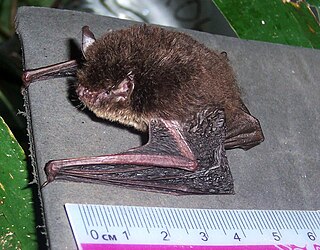
The wall-roosting mouse-eared bat, or Nepalese whiskered myotis is a species of vesper bat whose type locality is Nepal.
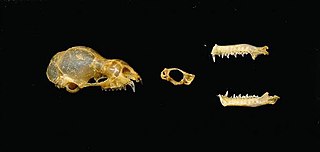
The ashy roundleaf bat is a species of bat in the family Hipposideridae found in Bhutan, Cambodia, India, Indonesia, Laos, Malaysia, Myanmar, Nepal, Pakistan, Thailand, and Vietnam.

The Pomona roundleaf bat, Pomona leaf-nosed bat, or Andersen's leaf-nosed bat is a species of bat in the family Hipposideridae that is endemic to India.

The Indian pipistrelle is a species of bat in the family Vespertilionidae found in Afghanistan, Bangladesh, Bhutan, Cambodia, India, Myanmar, Nepal, Pakistan, Sri Lanka, Thailand, and Vietnam.

Blyth's horseshoe bat is a species of bat in the family Rhinolophidae. It is found across southern Asia from Afghanistan to Vietnam. The species can be identified from its pointed, bifid sella.

The big-eared horseshoe bat is a bat species within the Rhinolophidae native to Asia.
The Japanese long-eared bat is a species of vesper bat endemic to Japan, where it is found in Hokkaido, Honshu and Shikoku. It has distinctive, long ears, hence its Japanese name, the 'rabbit bat'. Formerly included as a subspecies of the European bat Plecotus auritus, genetic studies now indicate Plecotus sacrimontis is a separate species.
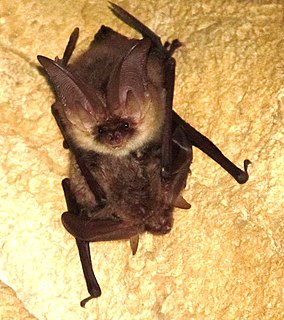
Ognev's long-eared bat is a species of bat found in Asia. By 2006, it was recognized as a separate species from the P. auritus species complex.
The Turkmen long-eared bat is a species of bat in the family Vespertilionidae. It is found in Kazakhstan, Uzbekistan and Turkmenistan, and possibly Mongolia.
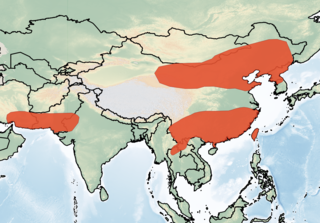
The Oriental serotine is a species of bat in the family Vespertilionidae. It is widespread and found throughout Asia.
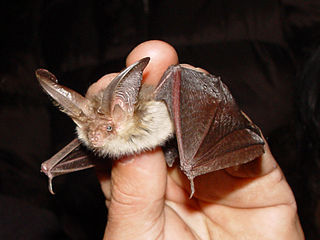
Plecotini is a tribe of bats in the family Vespertilionidae. It contains several genera found throughout the Northern Hemisphere, in Eurasia, North Africa, and North America. Several genera in this tribe are known as big-eared bats or long-eared bats. It also contains the spotted bat and barbastelles.
Strelkov's long-eared bat is a species of vesper bat found in mountainous regions of Central Asia.
Ward's long-eared bat is a species of vesper bat in the family Vespertilionidae. It is found in mountainous regions of South Asia and adjoining regions.
















